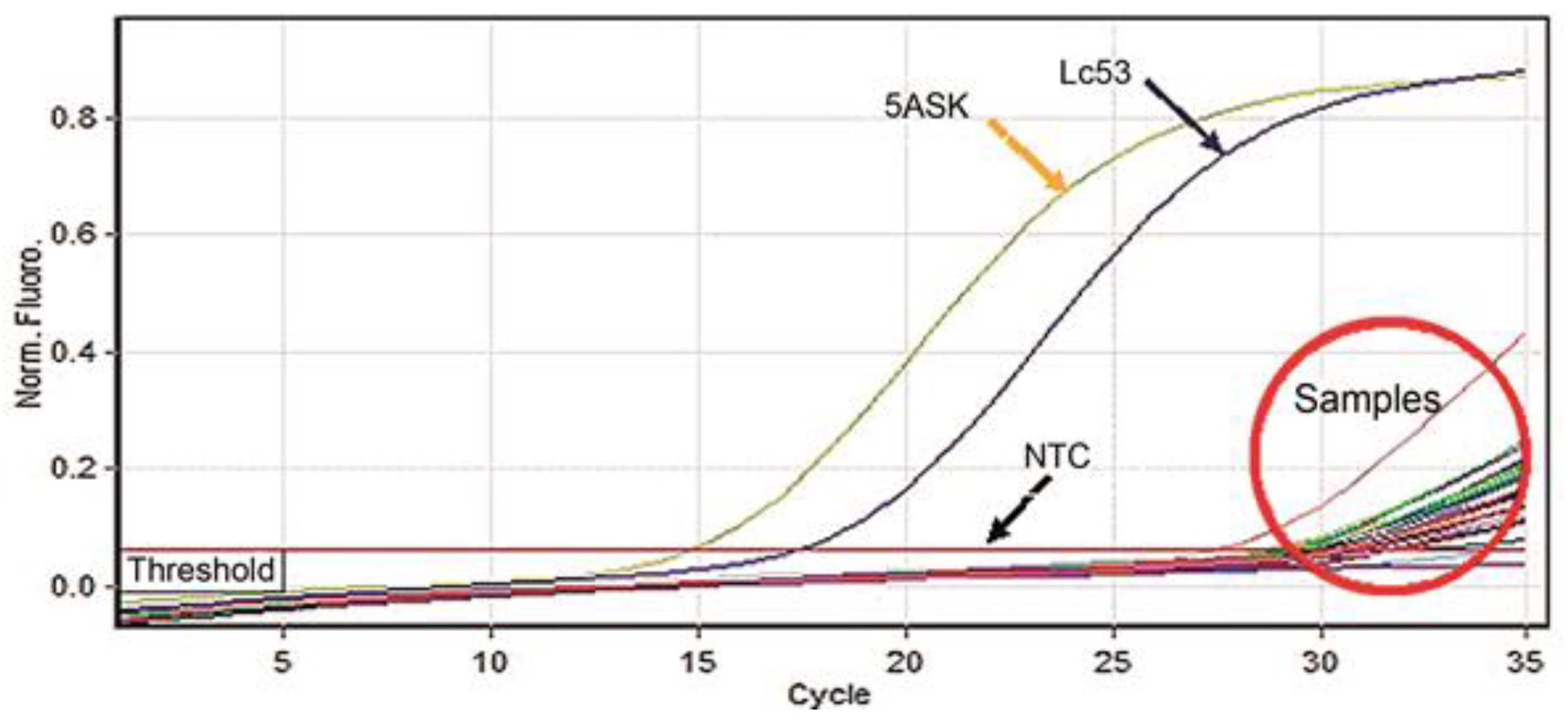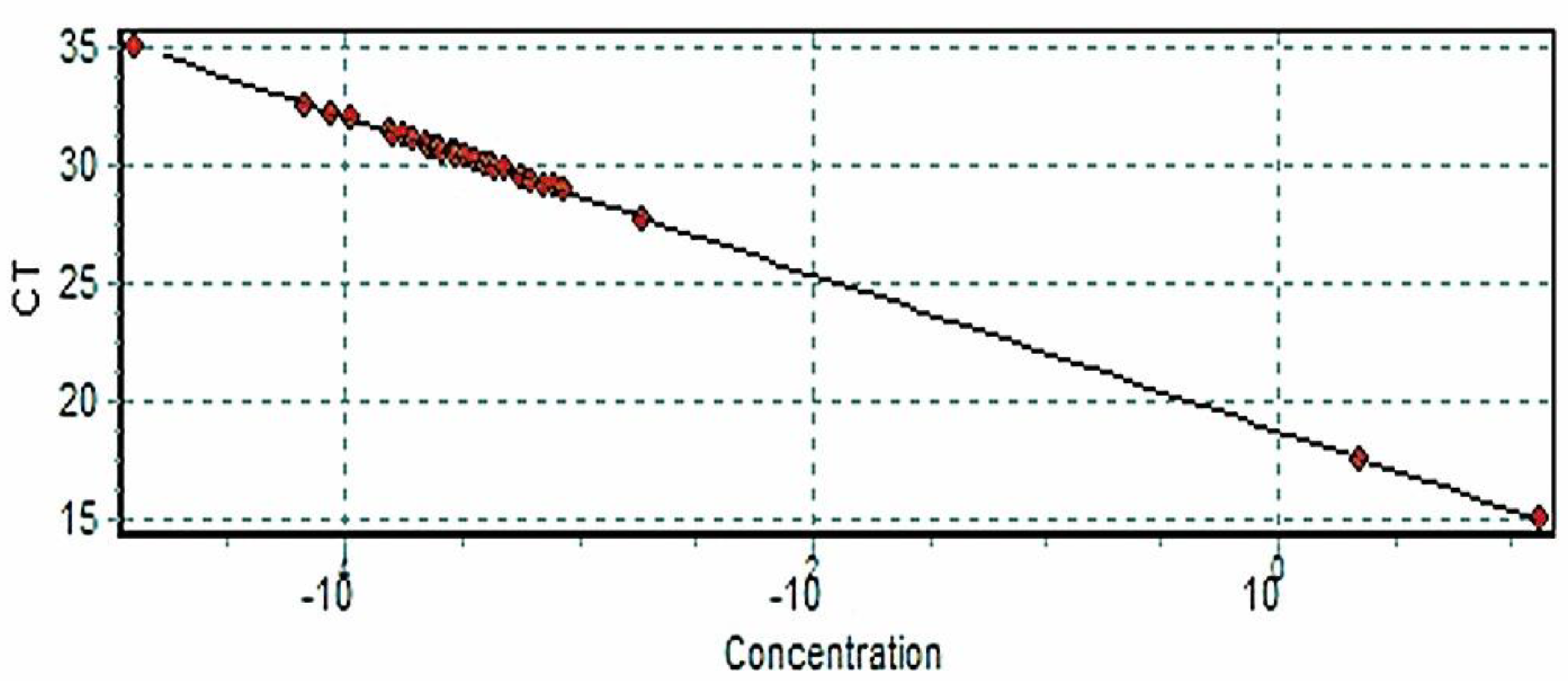Quantitative Detection of Leishmania in Rhipicephalus microplus and Amblyomma sabanerae in the Peruvian Amazon Basin
Abstract
1. Introduction
2. Materials and Methods
2.1. Ethical Aspects and Fieldwork
2.2. Collection and Taxonomic Classification
2.3. Molecular Study
2.4. Quantitative Analysis
3. Results
4. Discussion
5. Conclusions
Author Contributions
Funding
Institutional Review Board Statement
Informed Consent Statement
Data Availability Statement
Conflicts of Interest
References
- Ginebra: Centro de Prensa; Organización Mundial de la Salud. Leishmaniasis. 2022. Available online: https://www.who.int/es/news-room/fact-sheets/detail/leishmaniasis (accessed on 7 October 2022).
- Organización Panamericana de la Salud. Leishmaniasis [Internet]; Oficina Regional para las Américas de la Organización Mundial de la Salud: Washington, DC, USA, 2022; Available online: https://www.paho.org/es/temas/leishmaniasis (accessed on 7 October 2022).
- Alvar, J.; Vélez, I.D.; Bern, C.; Herrero, M.; Desjeux, P.; Cano, J.; Jannin, J.; den Boer, M. Leishmaniasis worldwide and global estimates of its incidence. PLoS ONE 2012, 7, e35671. [Google Scholar] [CrossRef]
- Lopes, E.G.; Geraldo, C.A.; Marcili, A.; Silva, R.D.; Keid, L.B.; Oliveira, T.M.F.D.S.; Soares, R.M. Performance of conventional PCRs based on primers directed to nuclear and mitochondrial genes for the detection and identification of Leishmania spp. Rev. Inst. Med. Trop. Sao Paulo. 2016, 58, 41. [Google Scholar] [CrossRef] [PubMed][Green Version]
- Romero, G.A.; Guerra, M.V.; Paes, M.G.; Cupolillo, E.; Toaldo, C.B.; Macêdo, V.O.; Fernandes, O. Sensitivity of the polymerase chain reaction for the diagnosis of cutaneous leishmaniasis due to Leishmania (Viannia) guyanensis. Acta Trop. 2001, 79, 225–229. [Google Scholar] [CrossRef]
- Vergel, C.; Walker, J.; Saravia, N.G. Amplification of human DNA by primers targeted to Leishmania kinetoplast DNA and post-genome considerations in the detection of parasites by a polymerase chain reaction. Am. J. Trop Med. Hyg. 2005, 72, 423–429. [Google Scholar] [CrossRef] [PubMed]
- Coelho, W.M.D.; Bresciani, K.D.S. Molecular and parasitological detection of Leishmania spp. in a dipteran of the species Tabanus importunus. Rev. Bras. Parasitol. Vet. 2013, 22, 605–607. [Google Scholar] [CrossRef] [PubMed][Green Version]
- Coutinho, M.T.Z.; Bueno, L.L.; Sterzik, A.; Fujiwara, R.T.; Botelho, J.R.; De Maria, M.; Genaro, O.; Linardi, P.M. Participation of Rhipicephalus sanguineus (Acari: Ixodidae) in the epidemiology of canine visceral leishmaniasis. Vet. Parasitol. 2005, 128, 149–155. [Google Scholar] [CrossRef] [PubMed]
- Trotta, M.; Nicetto, M.; Fogliazza, A.; Montarsi, F.; Caldin, M.; Furlanello, T.; Solano-Gallego, L. Detection of Leishmania infantum, Babesia canis, and rickettsiae in ticks removed from dogs living in Italy. Ticks Tick Borne Dis. 2012, 3, 294–297. [Google Scholar] [CrossRef]
- Dabaghmanesh, T.; Asgari, Q.; Moemenbellah-Fard, M.D.; Soltani, A.; Azizi, K. Natural transovarial and transstadial transmission of Leishmania infantum by naïve Rhipicephalus sanguineus ticks blood feeding on an endemically infected dog in Shiraz, south of Iran. Trans. R. Soc. Trop. Med. Hyg. 2016, 110, 408–413. [Google Scholar] [CrossRef]
- Chen, Z.; Liu, Q.; Liu, J.-Q.; Xu, B.-L.; Lv, S.; Xia, S.; Zhou, X.-N. Tick-borne pathogens and associated co-infections in ticks collected from domestic animals in central China. Parasit Vectors 2014, 7, 237–245. [Google Scholar] [CrossRef]
- Gonçalves, L.R.; Filgueira, K.D.; Ahid, S.M.M.; Pereira, J.S.; Vale, A.M.D.; Machado, R.Z.; André, M.R. Study on coinfecting vector-borne pathogens in dogs and ticks in Rio Grande do Norte, Brazil. Rev. Bras. Parasitol. Veterinária 2014, 23, 407–412. [Google Scholar] [CrossRef][Green Version]
- Solano-Gallego, L.; Rossi, L.; Scroccaro, A.M.; Montarsi, F.; Caldin, M.; Furlanello, T.; Trotta, M. Detection of Leishmania infantum DNA mainly in Rhipicephalus sanguineus male ticks removed from dogs living in endemic areas of canine leishmaniosis. Parasit Vectors 2012, 5, 98–104. [Google Scholar] [CrossRef] [PubMed]
- Salvatore, D.; Aureli, S.; Baldelli, R.; Di Francesco, A.; Tampieri, M.P.; Galuppi, R. Molecular evidence of Leishmania infantum in Ixodes ricinus ticks from dogs and cats, in Italy. Vet. Ital. 2014, 50, 307–312. [Google Scholar] [PubMed]
- Nicolas, L.; Prina, E.; Lang, T. Real-Time PCR for Detection and Quantitation of Leishmania in mouse tissues. J. Clin. Microbiol. 2002, 40, 1666–1669. [Google Scholar] [CrossRef]
- Barros-Battesti, D.; Arzua, M.; Bechara, H. Carrapatos de Importância Medico-Veterinaria da Região Neotropical: Um Guia Ilustrado Para Identificação de Espécies, 10th ed.; Butantan publicação: Sao Paulo, Brazil, 2006; p. 223.
- Roche Diagnostics GmbH. High Pure PCR Template Preparation Kit; Roche Diagnostics GmbH: Mannheim, Germany, 2008. [Google Scholar]
- Van Eys, G.J.; Schoone, G.J.; Kroon, N.C.; Ebeling, S.B. Sequence analysis of small subunit ribosomal RNA genes and its use for detection and identification of Leishmania parasites. Mol. Biochem. Parasitol. 1992, 51, 133–142. [Google Scholar]
- Gomes, L.I.; Gonzaga, F.M.; De Morais-Teixeira, E.; de Souza-Lima, B.S.; Freire, V.V.; Rabello, A. Validation of quantitative real-time PCR for the in vitro assessment of antileishmanial drug activity. Exp. Parasitol. 2012, 131, 175–179. [Google Scholar] [CrossRef] [PubMed]
- de Morais, R.C.S.; da Cunha Gonçalves-de-Albuquerque, S.; e Silva, R.P.; Costa, P.L.; da Silva, K.G.; da Silva, F.J.; Brandão-Filho, S.P.; Dantas-Torres, F.; de Paiva-Cavalcanti, M. Detection and quantification of Leishmania braziliensis in ectoparasites from dogs. Vet. Parasitol. 2013, 196, 506–508. [Google Scholar] [CrossRef] [PubMed]
- Guerbouj, S.; Mkada Driss, I.; Guizani, I. Molecular Tools for Understanding Eco-Epidemiology, Diversity and Pathogenesis of Leishmania Parasites. In Leishmaniasis—Trends in Epidemiology, Diagnosis and Treatment; InTech: Rijeka, Croatia, 2014; Volume 4, pp. 1–44. [Google Scholar]
- Wortmann, G.; Sweeney, C.; Houng, H.S.; Aronson, N.; Stiteler, J.; Jackson, J.; Ockenhouse, C. Rapid diagnosis of leishmaniasis by fluorogenic polymerase chain reaction. Am. J. Trop. Med. Hyg. 2001, 65, 583–587. [Google Scholar] [CrossRef] [PubMed]
- Viol, M.A.; Guerrero, F.D.; de Oliveira, B.C.M.; de Aquino, M.C.C.; Loiola, S.H.; de Melo, G.D.; de Souza Gomes, A.H.; Kanamura, C.T.; Garcia, M.V.; Andreotti, R.; et al. Identification of Leishmania spp. promastigotes in the intestines, ovaries, and salivary glands of Rhipicephalus sanguineus actively infesting dogs. Parasitol Res. Parasitol. Res. 2016, 115, 3479–3484. [Google Scholar] [CrossRef]
- Medeiros-Silva, V.; Gurgel-Gonçalves, R.; Nitz, N.; Morales, L.E.D.A.; Cruz, L.M.; Sobral, I.G.; Boité, M.C.; Ferreira, E.; Cupolillo, E.; Romero, G.A.S. Successful isolation of Leishmania infantum from Rhipicephalus sanguineus sensu lato (Acari: Ixodidae) collected from naturally infected dogs. BMC Vet. Res. 2015, 11, 258. [Google Scholar] [CrossRef]
- Magri, A.; Caffara, M.; Fioravanti, M.; Galuppi, R. Detection of Leishmania sp. kDNA in questing Ixodes ricinus (Acari, Ixodidae) from the Emilia-Romagna Region in northeastern Italy. Parasitol. Res. 2022, 121, 3331–3336. [Google Scholar] [CrossRef]
- Magri, A.; Galuppi, R.; Fioravanti, M.; Cafara, M. Survey on the presence of Leishmania sp. in peridomestic rodents from the Emilia-Romagna Region (North-Eastern Italy) on the presence of Leishmania sp. in peridomestic rodents from the Emilia-Romagna Region (North-Eastern Italy). Vet. Res. Commun. 2022. [Google Scholar] [CrossRef] [PubMed]
- Sgroi, G.; Iatta, R.; Veneziano, V.; Bezerra-Santos, M.; Lesiczka, P.; Hrazdislová, K.; Annoscia, G.; D’Alessio, N.; Golovchenko, M.; Rudenko, N.; et al. Molecular survey on tick-borne pathogens and Leishmania infantum in red foxes (Vulpes vulpes) from southern Italy. Ticks Tick-Borne Dis. 2021, 12, 101669. [Google Scholar] [CrossRef] [PubMed]
- Cazan, C.; Ionica, A.; Matei, I.; D’ Amico, G.; Muñoz, C.; Berriatua, E.; Dumitrache, M. Detection of Leishmania infantum DNA and antibodies against Anaplasma spp., Borrelia burgdorferi s.l. and Ehrlichia canis in a dog kennel in South-Central Romania. Acta Vet. Scand. 2020, 62, 42. [Google Scholar] [CrossRef] [PubMed]
- Rojas-Jaimes, J.E.; Correa-Núñez, G.H.; Rojas-Palomino, N.; Cáceres-Rey, O. Detección de Leishmania (V) guyanensis en ejemplares de Rhipicephalus (Boophilus) microplus (Acari: Ixodidae) recolectados en pecaríes de collar (Pecari tajacu). Biomédica 2017, 37 (Suppl. S2), 208–214. [Google Scholar] [CrossRef] [PubMed]
- del Valle-Mendoza, J.; Rojas-Jaimes, J.; Vásquez-Achaya, F.; Aguilar-Luis, M.A.; Correa-Nuñez, G.; Silva-Caso, W.; Lescano, A.G.; Song, X.; Liu, Q.; Li, D. Molecular identification of Bartonella bacilliformis in ticks collected from two species of wild mammals in Madre de Dios: Peru. BMC Res. Notes 2018, 11, 405. [Google Scholar] [CrossRef]
- Medina, R. Leishmaniasis experimental en animales silvestres. Dermatol. Venez. 1966, 1, 91–119. [Google Scholar]
- Centro Nacional de Epidemiologia. Prevención y Control de Enfermedades Casos de Leishmaniosis por años. Años 2000–2017*. Perú. 2017. Available online: http://www.dge.gob.pe/portal/docs/vigilancia/sala/2017/SE44/leishmaniosis.pdf (accessed on 6 June 2018).


| Detection Percentage of Studied Ticks Parasitized by Leishmania sp. | Gender | Taxonomic Classification of the Tick | Host | Concentration Range of DNA of Leishmania Per Tick (fg/µL) | Range Number of Parasites Per Tick |
|---|---|---|---|---|---|
| Total 22/23 (95.7%) Males (52.2%) Females (26.1%) Nymphs (17.4%) | 12 Males (52.2%) 7 Females (30.4%) 4 Nymphs (17.4%) | R. microplus | Pecari tajacu | 12–769 | 34.1–2197.1 |
| Detection percentage of studied ticks parasitized by Leishmania sp. | Gender | Taxonomic classification of the tick | Host | Concentration range of DNA of Leishmania per tick (fg/µL) | Range number of parasites per tick |
| Total 9/10 (90%) Adult (100%) | 10 Males (100%) | A. sabanerae | Chelonoidis denticulata | 157–1900 | 448.6–5428.6 |
Publisher’s Note: MDPI stays neutral with regard to jurisdictional claims in published maps and institutional affiliations. |
© 2022 by the authors. Licensee MDPI, Basel, Switzerland. This article is an open access article distributed under the terms and conditions of the Creative Commons Attribution (CC BY) license (https://creativecommons.org/licenses/by/4.0/).
Share and Cite
Rojas-Jaimes, J.; Correa-Núñez, G.H.; Donayre, L.; Lescano, A.G. Quantitative Detection of Leishmania in Rhipicephalus microplus and Amblyomma sabanerae in the Peruvian Amazon Basin. Trop. Med. Infect. Dis. 2022, 7, 358. https://doi.org/10.3390/tropicalmed7110358
Rojas-Jaimes J, Correa-Núñez GH, Donayre L, Lescano AG. Quantitative Detection of Leishmania in Rhipicephalus microplus and Amblyomma sabanerae in the Peruvian Amazon Basin. Tropical Medicine and Infectious Disease. 2022; 7(11):358. https://doi.org/10.3390/tropicalmed7110358
Chicago/Turabian StyleRojas-Jaimes, Jesús, Germán H. Correa-Núñez, Lisa Donayre, and Andres G. Lescano. 2022. "Quantitative Detection of Leishmania in Rhipicephalus microplus and Amblyomma sabanerae in the Peruvian Amazon Basin" Tropical Medicine and Infectious Disease 7, no. 11: 358. https://doi.org/10.3390/tropicalmed7110358
APA StyleRojas-Jaimes, J., Correa-Núñez, G. H., Donayre, L., & Lescano, A. G. (2022). Quantitative Detection of Leishmania in Rhipicephalus microplus and Amblyomma sabanerae in the Peruvian Amazon Basin. Tropical Medicine and Infectious Disease, 7(11), 358. https://doi.org/10.3390/tropicalmed7110358









